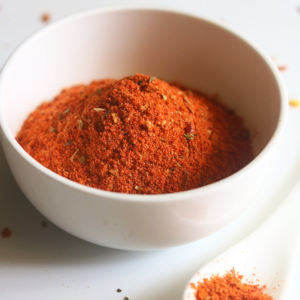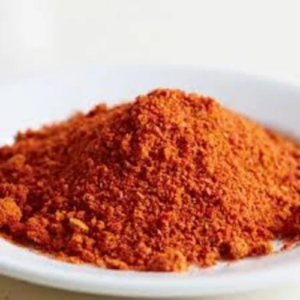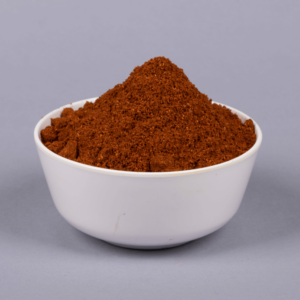Description
Key Ingredients in Sambhar Masala:
Sambhar masala is a carefully balanced blend of spices and herbs that vary slightly from region to region, but the following ingredients are commonly found in most variations:
- Coriander Seeds: Coriander provides a mild, slightly citrusy flavor that serves as the base of the masala, giving it a refreshing and aromatic note.
- Cumin Seeds: Cumin is earthy and slightly nutty, offering a warm, aromatic flavor that pairs well with the other spices.
- Mustard Seeds: Mustard seeds give the masala a bit of sharpness and heat, adding a slight bitterness that balances the other flavors.
- Fenugreek Seeds: Fenugreek has a slightly bitter flavor with a nutty sweetness, adding complexity and depth to the masala.
- Black Peppercorns: Black pepper brings a mild heat and pungency to the blend, enhancing the spiciness without overpowering it.
- Dry Red Chilies: Red chilies contribute both heat and color to the masala, giving it the signature spiciness that sambhar is known for.
- Turmeric: Turmeric has an earthy, slightly bitter taste, and adds the signature yellow color to the sambhar. It also contributes its anti-inflammatory properties.
- Asafoetida (Hing): Asafoetida has a strong, pungent flavor that adds a savory note to sambhar masala, with digestive properties that help balance the richness of the stew.
- Tamarind: While not always part of the masala, tamarind is often added to sambhar for its sour, tangy flavor, which provides the signature tanginess in sambhar.
- Curry Leaves: Curry leaves, often used fresh, can also be included in the masala blend. They add an aromatic, slightly bitter flavor that enhances the overall taste.
- Caraway Seeds (Ajwain): Some regional versions of sambhar masala include ajwain for a slightly sharp, thyme-like flavor.
Flavor Profile:
- Tangy and Earthy: The combination of tamarind (if included) and turmeric gives sambhar a tangy, earthy foundation. Coriander and cumin add a grounding, slightly citrusy flavor.
- Spicy and Pungent: Dry red chilies, black pepper, and mustard seeds bring a bit of heat to the dish. The pungency of asafoetida and the heat from chilies give sambhar its characteristic kick.
- Warm and Aromatic: The blend of spices like cumin, coriander, and fenugreek offers warmth and depth. Curry leaves (if included) bring a fragrant, slightly bitter note.
- Savory and Slightly Bitter: Fenugreek seeds and asafoetida introduce subtle bitterness, which is balanced by the tanginess of tamarind and the sweetness of cooked lentils and vegetables.
Common Uses:
Sambhar masala is primarily used in Sambhar, but it can be used in other dishes as well:
- Sambhar: The primary use of sambhar masala is to season sambhar, the hearty lentil stew. It’s added during the cooking process, typically after tempering the spices in hot oil or ghee (clarified butter).
- Vegetable Stews: Sambhar masala can be used to flavor other vegetable stews or curries, especially those made with lentils or beans. The spices in sambhar masala complement the flavors of both vegetables and legumes.
- Rice Dishes: The spice blend can be sprinkled on rice or mixed into rice-based dishes like sambhar rice or sambar pulao, giving the dish a rich, savory flavor.
- Marinades: Some people use sambhar masala as part of a marinade for meats or vegetables before grilling or roasting.
- Snacks: Sambhar masala can be sprinkled over roasted nuts or used to flavor snacks like bhel puri or puffed rice.
- Dosa or Idli Dipping Sauces: The masala can be mixed with yogurt or tamarind chutney to create a flavorful dipping sauce for idli or dosa.
Health Benefits (Claimed):
Sambhar masala is made from a variety of spices, many of which have traditional health benefits:
- Digestive Aid: Ingredients like cumin, fenugreek, and asafoetida are known for their digestive properties. They may help improve digestion and reduce bloating.
- Anti-inflammatory: Turmeric (curcumin) has anti-inflammatory properties, while black pepper and fenugreek also have some anti-inflammatory effects.
- Rich in Antioxidants: Spices like cumin, coriander, and turmeric contain antioxidants that help combat oxidative stress and protect the body from free radical damage.
- Boosts Immunity: Many of the ingredients in sambhar masala, including turmeric, mustard seeds, and curry leaves, are traditionally believed to support the immune system.
- Weight Management: Some spices in sambhar masala, such as cumin, fenugreek, and black pepper, are believed to help stimulate metabolism and support weight management efforts.
Regional Variations:
Sambhar masala can vary based on regional preferences and family recipes. Different regions of South India may adjust the blend of spices to suit local tastes:
- Tamil Nadu Sambhar Masala: In Tamil Nadu, sambhar is often made with a mix of lentils, vegetables like drumsticks (moringa), and a balanced blend of spices.
- Maharashtrian Sambhar: In Maharashtra, sambhar masala might have a more robust, earthy flavor, with the addition of dried coconut and other regional spices.
- Andhra Sambhar: Andhra sambhar tends to be spicier, with more emphasis on dried red chilies and black pepper, offering a sharper, hotter taste.
Preparation:
You can prepare sambhar masala from scratch by toasting and grinding the individual spices, or you can purchase pre-ground sambhar masala from stores. To make your own, here’s a basic method:
- Roast the Whole Spices: Dry roast the whole spices (coriander, cumin, mustard, fenugreek seeds, and dry red chilies) in a hot pan until fragrant. Be careful not to burn them.
- Grind the Spices: Once cooled, grind the roasted spices into a fine powder using a spice grinder or mortar and pestle.
- Store: Store the ground sambhar masala in an airtight container away from light and moisture for long shelf life.
Alternatively, you can buy ready-made sambhar masala from the market, where the ingredients are pre-mixed and ready to use.
Conclusion:
Sambhar Masala is an essential spice blend in South Indian cuisine, providing a rich, warm, and aromatic flavor to Sambhar, the beloved lentil stew. Its complex blend of spices, such as cumin, coriander, mustard, and fenugreek, along with its tangy, spicy, and savory notes, makes it an ideal seasoning for not only stews but a variety of rice dishes, snacks, and even marinades. Whether you make your own from scratch or buy it pre-ground, sambhar masala is key to creating authentic South Indian flavors that are both comforting and nourishing.








